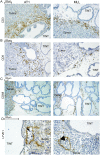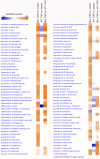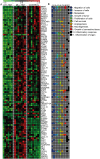Aggressive rat prostate tumors reprogram the benign parts of the prostate and regional lymph nodes prior to metastasis
- PMID: 28472073
- PMCID: PMC5417597
- DOI: 10.1371/journal.pone.0176679
Aggressive rat prostate tumors reprogram the benign parts of the prostate and regional lymph nodes prior to metastasis
Abstract
In order to grow and spread tumors need to interact with adjacent tissues. We therefore hypothesized that small but aggressive prostate cancers influence the rest of the prostate and regional lymph nodes differently than tumors that are more indolent. Poorly metastatic (Dunning AT1) or highly metastatic (Dunning MLL) rat prostate tumor cells were injected into the ventral prostate lobe of immunocompetent rats. After 10 days-when the tumors occupied about 30% of the prostate lobe and lymph node metastases were undetectable-the global gene expression in tumors, benign parts of the prostate, and regional iliac lymph nodes were examined to define tumor-induced changes related to preparation for future metastasis. The tumors induced profound effects on the gene expression profiles in the benign parts of the prostate and these were strikingly different in the two tumor models. Gene ontology enrichment analysis suggested that tumors with high metastatic capacity were more successful than less metastatic tumors in inducing tumor-promoting changes and suppressing anti-tumor immune responses in the entire prostate. Some of these differences such as altered angiogenesis, nerve density, accumulation of T-cells and macrophages were verified by immunohistochemistry. Gene expression alterations in the regional lymph nodes suggested decreased quantity and activation of immune cells in MLL-lymph nodes that were also verified by immunostaining. In summary, even when small highly metastatic prostate tumors can affect the entire tumor-bearing organ and pre-metastatic lymph nodes differently than less metastatic tumors. When the kinetics of these extratumoral influences (by us named TINT = tumor instructed normal tissue) are more precisely defined they could potentially be used as markers of disease aggressiveness and become therapeutic targets.
Conflict of interest statement
Figures










References
MeSH terms
LinkOut - more resources
Full Text Sources
Other Literature Sources
Medical
Research Materials

